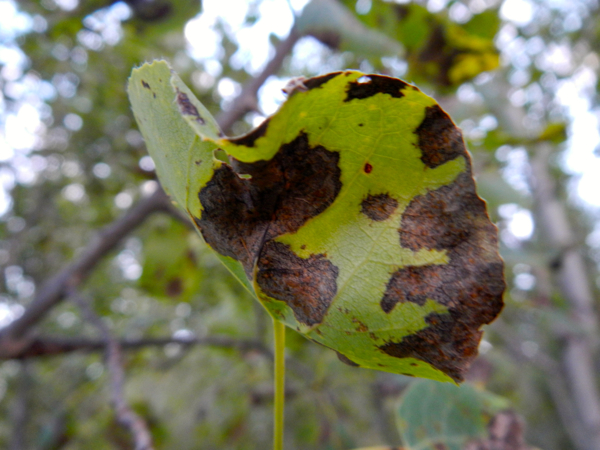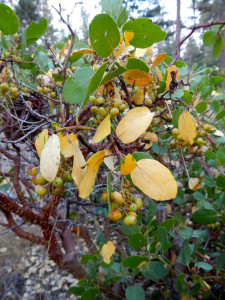Hues of autumn showing up prematurely

Aspen leaves at Taylor Creek on the South Shore are showing signs of stress from lack of water. Photos/Kathryn Reed
By Susan Wood
If a leaf or a cone falls in the forest, will anyone see the symptoms of change?
That’s the question botanists, foresters, climatologists and arborists may be asking in the age of an unprecedented Western drought.
Come fall, aspens represent the most recognizable tree that changes color in the Sierra Nevada. But from Rabe Meadow to Taylor Creek and Hope Valley to the Carson region, they appear stressed.
It’s August, and many leaves have either fallen to the ground, already prematurely turned yellow, started drooping or have been reduced to a crispy brown in some places.
“We’ve noticed in dry years they start to change color earlier than usual. They’ll run their course a little faster if they don’t get the moisture,” said Kelly Redmond, Western Regional Climate Center climatologist based in Reno, told Lake Tahoe News.
Redmond said there are two issues he looks at – timing and color. He’s also noticed this year the shades of colors are dimmer. Although Redmond is a regional El Nino expert, he doesn’t associate the trees trending differently with the weather phenomenon. He does point to drought, but believes more needs to be analyzed to clearly understand “phenology” – the study of plant life cycles and how they’re influenced by seasonal variations of climate.
“The whole business of what makes leaves change is not well established in the climate world,” he said.
Agreeing to some extent is Courtney Rowe, the Lake Tahoe Basin Management Unit forest botanist. She’s seen enough to assume that the aspens as well as our Jeffrey, sugar and lodgepole pines in addition to the white and red firs are in survival of the fittest mode. The willows change early anyway and haven’t deviated from that trend this year.
The aspens will drop leaves that consume too much energy to maintain with a lack of precipitation in the hopes of a better year ahead. Pine trees will unload the cones and needles because they become a pricey commodity.
“The lack of water is a cue to make the decision to get rid of leaves and wait for next year,” Rowe said of the environmental trigger. Dumping the leaves helps to reduce water use and stay alive.
It appears scientists aren’t the only ones noticing the change in the change of seasons.
Lindsay Gusses, who runs the LTBMU visitor center at Taylor Creek for the U.S. Forest Service, said visitors are often asking what is going on with the leaves in the groves characteristic of the South Shore region off Highway 89.
“Now with four years of drought we’re seeing it more and seeing it sooner,” Gusses said.
According to the U.S. Forest Service, 12.5 million trees have died off in California.
The fear is if the drought continues, the trees may produce fewer leaves or seeds, or worse yet, tree mortality could be more prevalent – whether it’s through the seedling dying or the tree itself taking a direct hit. And weaker trees tend to welcome more pathogens like the mountain pine beetle to invade.
The eco genetics of the trees weave their way into interpretive talks at Taylor Creek that Gusses hosts on the Rainbow Trail three times a week. Even children ask about the current conditions and the effects, Gusses said.
“They get curious,” she added.
And the trend travels away from Lake Tahoe.
Sorensen’s Resort in Hope Valley has built a business on mass visitation in the fall to view the leaves changing. Its customer base has already been asking questions about the tree’s abnormal behavior this summer, while noticing the wilted, fallen leaves.
“They seem a little more stressed this year. I think the whole forest is stressed,” Sorensen’s co-owner Patty Brissenden said, putting the whole West Coast into the eco equation.




The first week of August we were picnicking next to a year-round stream, in Alpine County. The flowers were blooming at our feet while the leaves from the Aspens were floating down from above. Definitely different.
I am predicting an early, wet winter. Time will tell.
Yes it surly has, I’m winter proofing my home as I have a feel
Susan Wood, I have also noticed the beginning of an early autumn.Pine needles turning brown early and stressed pine trees dropping their branches from the extended drought. Lets hope for more rain and lots of snow come winter. Old Long Skiis